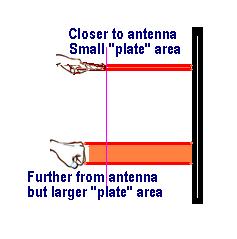"Hence a completely battery-powered setup is just looking for trouble, unless you play barefoot on the ground :-)" - rogue
No.. This is not the case!
It is EASY to create an adequate "ground antenna" from something as simple as a length of audio cable.. See the Battery Supply for EW ? (condensed and meaningful posts) -> Particularly the post with a heading:
"Re: Grounding / Earthing.." and the post by ChrisC which pastes the EW battery modification from Moog, and my following posting headed : "RE: Grounding / Earthing :: vs :: EW TRM Instructions."
In fact, "barefoot on the ground " doesnt help with a battery theremin unless its ground is connected to "ground".
The whole "Battery Supply for EW ? (condensed and meaningful posts)" thread has been as much, or more, about grounding as it has on the power supply side - which is a bit of a shame IMO, as the grounding is a subject that should not need this kind of exposition in a forum like this - Understanding the effect of ground is fundamental and essential for theremins - battery or mains powered.
Battery or mains driven also, essentially, require the same "conditions" which are not always obtained on a mains theremin unless care is taken.
The theremin is not a keyboard one can just plug and play, and expect optimum performance without any understanding of the mechanisms..
(I have a LOT of emails from people with grounding problems on mains powered theremins - many from parts of the world where wiring standards are, well, sub-standard.. Russia tops the list of enquiries I get** - and it seems that many setups are effectively "floating" - the mains "ground" connection in the sockets simply isnt connected.. IMO, this is shocking [pun intended] - but it is a fact of life - This is a hidden danger which only shows up when an instrument goes 'live' and electrocutes the operator, or when one connects an instrument like a theremin which depends on ground for correct operation.
I am fearful about giving advice in these situations - If one has mains equipment where their "ground" connections are all linked together, but where this does not connect to a "true" ground return, then if any of this equipment goes 'live' the whole lot goes 'live'.. If one has a conductive mat connected to this floating "ground", this mat will go 'live' in such an event - and the potential for a fatal accident is greatly increased.. So my advice always is to sort out the grounding problem unless one is only using a battery supply for ANY and ALL equipment connected to the floating "ground")
If you dont understand capacitance and the basics of how it works with regard to playing (and this includes understanding that you are acting as a variable capacitor between two "coupling elements" - one being the theremins antenna/s, the other being the THEREMINS INTERNAL "ground" or "0V" - and that this "internal ground" needs to be connected somehow to a large external "antenna" - as in, either all stuff connected to "real" ground, or some large conductive "coupler") , you are unlikely to know how to achieve optimum functioning of your theremin, and likely to be clueless when things (which can be easily fixed) go wrong.
Fred.
** I have actually been asked by Russian theremin promoters to design a theremin to overcome their problems related to grounding - offered real money for design of a battery powered theremin that will work without needing to rely on the mains supply or grounding provided by the mains outlet, and which is intrinsically safe..
What they want is impossible - As soon as the theremin is connected to anything powered by mains, even if it is running off its own battery supply and has its own ground mat or other ground - player coupling mechanism, its "ground potential" will be determined by the "ground potential" of whatever it is connected to..
Sure, I can get the theremin to work and have good player coupling - But I cannot do anything to ensure safety unless whatever is connected to the theremin is safe. . Alas, for the price they want to sell these theremins, I cannot even make a 555 based battery theremin anyway ;-) .. I believe they are now looking at buying LV-3 's.. Or at least they wanted me to get one and reverse-engineer it.. I refused.



